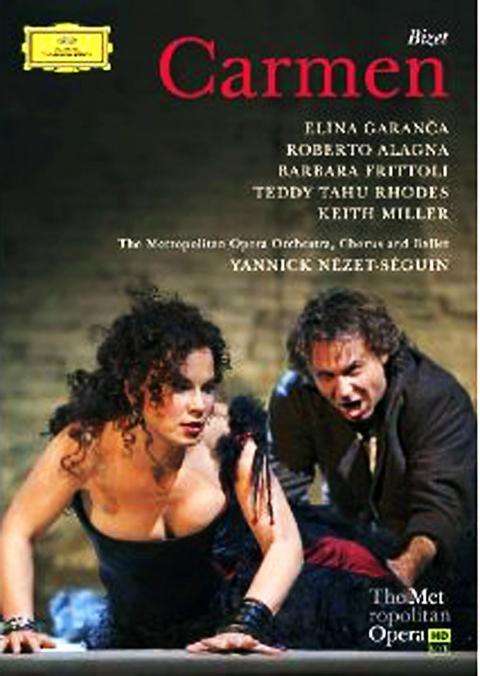One of the most attractive options this month comes in the form of an online transmission from Medici Arts, available for free until Dec. 31. It’s of Mozart’s Le Nozze di Figaro (The Marriage of Figaro) from the Opera Bastille in Paris, and it’s a re-creation of a famous and thankfully traditional production by the late Italian director Giorgio Strehler. It’s excellently sung and beautiful to look at, with just one disadvantage — the only subtitles to the Italian text are in French. To see it, go to www.medici.tv. You’ll have to sign up first, but that’s also free of charge.
A new Carmen from the Metropolitan Opera is bound to be an important event. It was to have starred Angela Georghiu as Carmen, opposite Roberto Alagna as Don Jose, but following this former couple’s separation the role of Carmen was taken by Elina Garanca. Teddy Tahu Rhodes as Escamillo was also a last-minute replacement.
The British theater director Richard Eyre updates the action to fascist Spain, and uses the Met’s revolving stage to move around a craggy wall so that it sometimes encloses the interior of a police station, sometimes displays the required Seville urban space, and sometimes loosely suggests the mountainous background of the gypsy camp. It’s not a particularly brilliant idea, and for some reason you have to settle for the cigarette factory workers making their entrance in Act One out of a trapdoor.

Nonetheless, Elina Garanca proves a powerful and convincing Carmen, while Alagna is very strong as Don Jose, though not the gullible, innocent youth the libretto really requires. Micaela, Don Jose’s loyal and loving first love, always seems the real heroine of this work, self-effacing though her music generally is, and Barbara Frittoli’s portrayal is especially effective.
This is one of those Met products originally designed for relay to various US cinemas, so you have Renee Fleming introducing the action and later interviewing some of the stars. Yannick Nezet-Seguin makes his Met debut as conductor.
A strong DVD that came my way recently shows Leonard Bernstein rehearsing Shostakovich’s Symphony No. 1 with an orchestra of music students in 1988 (original DVD release date 2008). It’s also from Medici Arts, and comes in a Blu-ray version if required.

First you see some rehearsals. These give Bernstein the opportunity to expatiate on Shostakovich and the musical fashions of his day. It was totally unacceptable in the 1920s to write in the lush style of Wagner, he explains, so instead the 19-year-old imitates the quirky and modish irony of the Parisians. But he couldn’t hold back the Romantic impulse forever, and it begins to take over in the third movement. Instrumentalists, even young ones, must observe these changes, he says.
Then you see the performance complete, and it’s marvelous — an extraordinary achievement with a work that was originally only a required graduation exercise and isn’t usually rated very highly. This DVD, however, allows you to get under the symphony’s skin in what turns out to be a unique manner.
The DVD that affected me most this month is one I stumbled on purely by chance — it’s long been available in EMI’s Classic Archive series. It features the French violinist Christian Ferras playing the Sibelius and Stravinsky violin concertos and Franck’s Violin Sonata, all in performances from the 1960s filmed in black-and-white, together with some shorter pieces.

It was the Sibelius concerto that really gripped me. The sound quality is mediocre at best, but I must have watched the slow movement 20 times. This is violin playing in the high Romantic tradition, but by a heavily built middle-aged man in tears. The tears well up early on and if, by the end, they’re not exactly seen splashing onto the violin, that may just be because of the camera angle. So I looked Ferras up, and it transpired he was an alcoholic who took his own life in 1982.
I can’t recommend this DVD (also available on Blu-ray) forcefully enough. The Stravinsky can be ignored — the feeling is unavoidable that this wasn’t Ferras’ kind of music, and maybe not anyone’s — and some of the minor items feel like fill-ups. The great strengths are the Sibelius and the Franck. There’s also a bonus of Zino Francescatti playing Mozart’s Violin Concerto No. 3, also in the 1960s, and the contrast of personalities, and hence of styles, couldn’t be greater. He even makes it sound like a great work.
Finally, in March we reviewed the marginally classical CD from Sting, If on a Winter’s Night. A two-DVD set called A Winter’s Night — Live From Durham Cathedral is now also available, and would make a very appropriate Christmas present (DGM 06025 272 5385). This was very much a homecoming to the UK’s northeast for Sting, as the long nostalgic film on the second DVD amply demonstrates. And there’s a sincerity and lack of PR gloss about the whole proceeding that I didn’t always feel with Carmen.

June 9 to June 15 A photo of two men riding trendy high-wheel Penny-Farthing bicycles past a Qing Dynasty gate aptly captures the essence of Taipei in 1897 — a newly colonized city on the cusp of great change. The Japanese began making significant modifications to the cityscape in 1899, tearing down Qing-era structures, widening boulevards and installing Western-style infrastructure and buildings. The photographer, Minosuke Imamura, only spent a year in Taiwan as a cartographer for the governor-general’s office, but he left behind a treasure trove of 130 images showing life at the onset of Japanese rule, spanning July 1897 to

One of the most important gripes that Taiwanese have about the Democratic Progressive Party (DPP) is that it has failed to deliver concretely on higher wages, housing prices and other bread-and-butter issues. The parallel complaint is that the DPP cares only about glamor issues, such as removing markers of Chinese Nationalist Party (KMT) colonialism by renaming them, or what the KMT codes as “de-Sinification.” Once again, as a critical election looms, the DPP is presenting evidence for that charge. The KMT was quick to jump on the recent proposal of the Ministry of the Interior (MOI) to rename roads that symbolize

On the evening of June 1, Control Yuan Secretary-General Lee Chun-yi (李俊俋) apologized and resigned in disgrace. His crime was instructing his driver to use a Control Yuan vehicle to transport his dog to a pet grooming salon. The Control Yuan is the government branch that investigates, audits and impeaches government officials for, among other things, misuse of government funds, so his misuse of a government vehicle was highly inappropriate. If this story were told to anyone living in the golden era of swaggering gangsters, flashy nouveau riche businessmen, and corrupt “black gold” politics of the 1980s and 1990s, they would have laughed.

In an interview posted online by United Daily News (UDN) on May 26, current Chinese Nationalist Party (KMT) Chairman Eric Chu (朱立倫) was asked about Taichung Mayor Lu Shiow-yen (盧秀燕) replacing him as party chair. Though not yet officially running, by the customs of Taiwan politics, Lu has been signalling she is both running for party chair and to be the party’s 2028 presidential candidate. She told an international media outlet that she was considering a run. She also gave a speech in Keelung on national priorities and foreign affairs. For details, see the May 23 edition of this column,